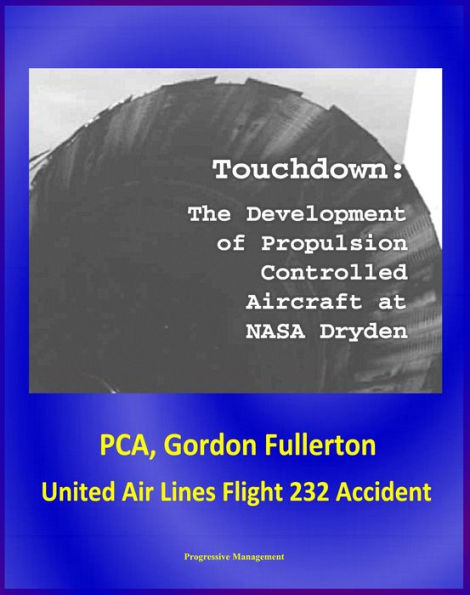This monograph relates the important history of the Propulsion Controlled Aircraft project at NASA's Dryden Flight Research Center. Spurred by a number of airplane crashes caused by the loss of hydraulic flight controls, a NASA-industry team lead by Frank W. Burcham and C. Gordon Fullerton developed a way to land an aircraft safely using only engine thrust to control the airplane.
In spite of initial skepticism, the team discovered that, by manually manipulating an airplane's thrust, there was adequate control for extended up-and-away flight. However, there was not adequate control precision for safe runway landings because of the small control forces, slow response, and difficulty in damping the airplane phugoid and Dutch roll oscillations. The team therefore conceived, developed, and tested the first computerized Propulsion Controlled Aircraft (PCA) system. The PCA system takes pilot commands, uses feedback from airplane measurements, and computes commands for the thrust of each engine, yielding much more precise control. Pitch rate and velocity feedback damp the phugoid oscillation, while yaw rate feedback damps the Dutch roll motion.
The team tested the PCA system in simulators and conducted flight research in F-15 and MD-11 airplanes. Later, they developed less sophisticated variants of PCA called PCA Lite and PCA Ultralite to make the system cheaper and therefore more attractive to industry. This monograph tells the PCA story in a nontechnical way with emphasis on the human aspects of the engineering and flight-research effort. It thereby supplements the extensive technical literature on PCA and makes the development of this technology accessible to a wide audience.
This monograph relates the important history of the Propulsion Controlled Aircraft project at NASA's Dryden Flight Research Center. Spurred by a number of airplane crashes caused by the loss of hydraulic flight controls, a NASA-industry team lead by Frank W. Burcham and C. Gordon Fullerton developed a way to land an aircraft safely using only engine thrust to control the airplane.
In spite of initial skepticism, the team discovered that, by manually manipulating an airplane's thrust, there was adequate control for extended up-and-away flight. However, there was not adequate control precision for safe runway landings because of the small control forces, slow response, and difficulty in damping the airplane phugoid and Dutch roll oscillations. The team therefore conceived, developed, and tested the first computerized Propulsion Controlled Aircraft (PCA) system. The PCA system takes pilot commands, uses feedback from airplane measurements, and computes commands for the thrust of each engine, yielding much more precise control. Pitch rate and velocity feedback damp the phugoid oscillation, while yaw rate feedback damps the Dutch roll motion.
The team tested the PCA system in simulators and conducted flight research in F-15 and MD-11 airplanes. Later, they developed less sophisticated variants of PCA called PCA Lite and PCA Ultralite to make the system cheaper and therefore more attractive to industry. This monograph tells the PCA story in a nontechnical way with emphasis on the human aspects of the engineering and flight-research effort. It thereby supplements the extensive technical literature on PCA and makes the development of this technology accessible to a wide audience.

Touchdown: The Development of Propulsion Controlled Aircraft at NASA Dryden - PCA, Gordon Fullerton, United Air Lines Flight 232 Accident

Touchdown: The Development of Propulsion Controlled Aircraft at NASA Dryden - PCA, Gordon Fullerton, United Air Lines Flight 232 Accident

Product Details
| BN ID: | 2940044732483 |
|---|---|
| Publisher: | Progressive Management |
| Publication date: | 07/20/2012 |
| Sold by: | Smashwords |
| Format: | eBook |
| File size: | 189 KB |
